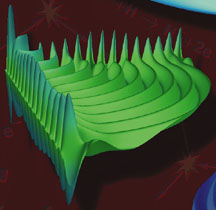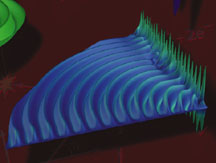
After
the interaction, the two electrons fly out at an angle to each other, leaving
the proton behind; because electrons are identical, there is no way to distinguish
between the initially bound and the initially free electron. The likelihood
that a given incoming state will result in an outgoing state with the particles
at specific angles and energies is the “cross section” for that result.

![]()
Cross sections for quantum-mechanical processes are
derived from the system’s wave function, solutions of the Schrödinger equation
which yield probabilities of finding the entities involved in a certain
state. What makes scattering problems so difficult is that the wave functions
are not localized but extend over all space.
What makes scattering problems involving charged particles even more difficult is that "Coulomb interactions are forever," says Bill McCurdy, Berkeley Lab’s Associate Laboratory Director for Computing Sciences. As far as the mathematics of the Schrödinger equation is concerned, the electromagnetic force between charged particles acts over infinitely long distances.
These infinities make it essentially impossible to find an exact formula for the final state of scattering. McCurdy says, "The form of the wave function where all three particles are widely separated is so intractable that no computer-aided numerical approach has been able to incorporate it explicitly."
McCurdy and his longtime collaborator Thomas Rescigno, a staff physicist at Livermore Lab, working with doctoral candidate Mark Baertschy of UC Davis and postdoctoral fellow William Isaacs at Berkeley Lab, tackled the three-charged-body scattering problem using the Cray T3E supercomputer at the National Energy Research Scientific Computing Center (NERSC), located at Berkeley Lab, and the IBM Blue Pacific computer at Livermore Lab.
The intractability of the standard approach
"obviously hasn’t stopped people from working with plasmas and other ionization
phenomena," Rescigno notes. "Mathematically, they’ve come up with incredibly
artful dodges, and some of them even seem to work"—but no such approximation
gives all the details of the process correctly.
![]()

The method developed by McCurdy and Rescigno and their colleagues, on the other hand, allows the calculation of a highly accurate wave function for the outgoing state that can be interrogated for details about the collision dynamics in the same way an experimenter would interrogate a physical system.
They begin with a mathematical transformation of the Schrödinger equation called "exterior complex scaling," invented by Caltech’s Barry Simon in 1979, which makes it possible to treat the outgoing particles not as if their wave functions extend to infinity—as they must be treated conventionally— but instead as if they simply vanish at large distances from the nucleus.
"Using this transformation we can compute accurate solutions of the quantum-mechanical wave function of the outgoing particles," McCurdy says, because in regions that correspond to physical reality, the transformation gives the correct outgoing waveform. "From these solutions we extract all the dynamical information of the interaction."
Once the wave function has been calculated, it must be analyzed by computing the "quantum mechanical flux," a means of finding the distribution of probability densities that dates from the 1920s. This computationally intensive process can yield the probability of producing electrons at specific energies and directions from the ionized atom.
Although earlier methods of approximation, such as those developed
by Igor Bray and Andres Stelbovics, constituted important advances and could
give the total cross section for ionization of a scattering reaction, they
could not reliably give a complete description of the directions or energies
of outgoing electrons. By contrast, says Rescigno, "our work produces absolute
answers at the ultimate level of detail."
BILL
McCURDY
![]()

Bill
McCurdy became fascinated with the possibilities of scientific
computing in the computational "dark ages" of the 1970s,
while studying chemistry at Tulane and Caltech. Not one
to wait around, McCurdy promptly founded the Ohio Supercomputer
Center; later he became director of the National Energy
Research Supercomputer Center (NERSC’s previous incarnation)
at Lawrence Livermore National Laboratory. Through his
continuing research, often in collaboration with Livermore’s
Tom Rescigno, McCurdy has made fundamental contributions
to computational chemistry.
![]()
Comparison with real scattering experiments, such as those recently published by J. Röder et al, who scattered electrons incoming at precise energies from hydrogen atoms, then carefully measured the angles and energies of the outgoing electrons, prove the accuracy of the new method. The experimental data points match the graph of the cross sections calculated by Rescigno, Baertschy, Isaacs, and McCurdy with astonishing exactitude.
"Quantum chemistry was founded when the helium atom with two bound electrons was solved in the 1950s," McCurdy says. Even if specific methods have changed, "those calculations showed that the molecular problems of quantum chemistry were in principle solvable. What we have done is analogous. The details of our method probably won’t survive, but we’ve taken a big step toward treating ionizing collisions of electrons with more complicated atoms and molecules."
While noting the irony, the researchers find it encouraging that the same supercomputing power and sophisticated software tools built to investigate the complexity of increasingly larger systems could be used—indeed, were essential— "to answer a basic physics question for one of the simplest systems imaginable in physics and chemistry." — Paul Preuss
|
Next > | |||